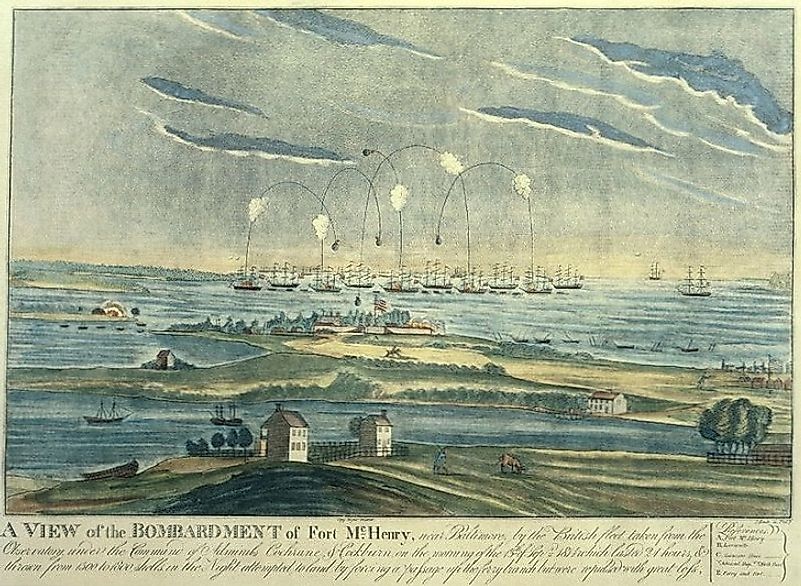Battle Of Baltimore - War Of 1812

5. Background and Initial Formation
The Battle of Baltimore, alternatively known as the Battle of Fort McHenry, was a sea-cum-land battle that was fought between British invaders and American defenders in the War of 1812. The battle got under way as American forces tried to repulse land and sea invasions by the British off of the busy seaport of Baltimore in Maryland. This battle resulted in the killing of a leading commander of the British forces. The major bone of contention between the Americans and their British rivals in the war at large was a contention over preservation of the ‘Free Trade and Sailors’ Rights’ maritime regulations. The Americans felt that the British had infringed upon these rights during their Napoleonic War with France, as they had boarded American ships without due cause and forced sailors into service on their own ships (often referred to as ‘Impressment’).
4. MAKEUP OF THE FORCES
The two protagonists in this battle were the United States and Great Britain. The commanders on the British side were Robert Ross, Arthur Brooke, and Alexander Cochrane. Meanwhile, directing the United States forces’ command, the leaders were Samuel Smith, George Armistead, and John Stricker. Due to the fact that this battle was fought upon various fronts on land and sea alike, the military strength for each side varied within each of these battle venues as well. In total, the military strength of Great Britain was in the area was estimated to include 5,000 infantry soldiers on land and 19 warships at sea. On the other hand, the strength of the Americans included 2,000 infantry and militia at North Point, and 1,000 infantry and militia at Fort McHenry. The ground troops were supported by 20 artillery pieces, and had additional defensive reinforcements available that included 8,000 militiamen and 150 artillery pieces.
3. DESCRIPTION OF THE BATTLE
The British strategy to successfully secure Baltimore hinged upon their success at Fort McHenry, a point that was considered key to the city’s defense. Another strategy the British used was the imposition of a trade blockade, which severely diminished trade between the two countries, and threatened to inflict a major morale blow among the Americans. On September 12th , the British fleet approached Baltimore through North Point near the mouth of the Patapsco River. A troop of about 4,500 of their men marched to Baltimore as their warships were moving up along the Patapsco River and further toward Fort McHenry. These ships opened up a twenty-five- hour bombardment on the fort, but its American commanders would refuse to surrender.
2. OUTCOMES
The resilience of the Americans forced the British fleet to withdraw down the Patapsco River, and the garrison flag raised over Fort McHenry was the first indication of the Americans’ breakthrough in the battle. The story was no different on land. In a skirmish that was later termed as the Battle of North Point, the event resulted in the greatest British casualty, their esteemed commander Major General Robert Ross. As a result, the British therefore had no choice but to withdraw. In the overall fighting, the casualties incurred at North Point included between 42 and 46 British killed and between 279 and 295 wounded, while the Americans killed there were 24, American wounded were 139, and those captured were 50. At Fort McHenry, one British was wounded, while 4 Americans were killed and 24 more were wounded.
1. Historical Significance and Legacy
The Battle of Baltimore played a significance role in the history of the United States. It revealed the commitment and bravery of the Americans to defend their nation. Were it not for their courageous and relentless defense of Baltimore, the United States would have gone the way of Washington, D.C., which had been largely decimated as it was burned and captured by the British. This battle also led to the recognition of Fort McHenry as an icon in the American history, as poet Francis Scott Key wrote the Star-Spangled Banner (the U.S. national anthem) as he watched the bombardment of Fort McHenry firsthand. On Christmas Eve of 1814, the two nations signed the Treaty of Ghent, ending the war and paving the way for better diplomacy between the two English-speaking countries “across the pond” from one another. Following the war, the resumption of trade between them would mutually strengthen the economies of the two warring nations. For most of the two centuries since, the U.S. and United Kingdom have been strong allies.







